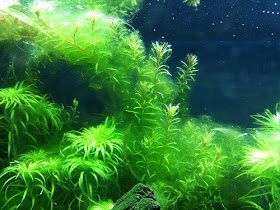One thing that most annoying and often make frustrating on aquarium plants care is the algae problems. Algae usually appears in the aquarium so we put plants or fish. The large majority of aquarists have found themselves confronted with undesirable levels of algae that are sometimes difficult to combat. Generally speaking, it is better to avoid excess growth in the first place than to have to try to fight it – often with varying degrees of success.
Algae overgrowth can be recognized by its greenish or yellow-brown color, while whitish or gray filamentous masses, made up of bacteria and fungi, may also bi mixed in with algae. This type of growth can form quite thick layers on the glass panes, the bed, and the décor, appearing as filamentous tufts or even completely covering other green algae.
While a modest presence of algae can be considered a sign of equilibrium, this overgrowth is evidence of a degree of imbalance, and so algae are often referred o as biological indicators. We must be careful, however, as every live aquarium is a special case, and applying a generalization to a specific situation could ultimately lead to the wrong conclusions.

Apart from being an eyesore, excess algae grow on the panes, reducing the visibility. They attach themselves to plants and proliferate, with the subsequent risk of suffocating their hosts, as the plants are prevented from exchanging gases and absorbing the salts in the water. Finally, they incrust themselves on the slightest details in the décor, which does nothing to enhance the visual effect.
But, algae also give their advantages. These are substantial. Algae consume nitrogenous substances, particularly nitrates, and sometimes ammonia. This is the normal role of plants in fresh water, and algae can therefore complement this action or, on the contrary, exert an antagonistic effect by diverting nutritious salts away from the plants. The vegetation is less abundant in marine tanks, and so algae – particularly the filamentous green ones – can play an important role.
Algae can also be grazed or ground by some fish. In fresh water, this applies to the Poeciliids and the species known as “suckers” or “washers” (Gyrinocbeilus, Ancistrus, Hypostomus, Pnaque, Otoclinchus, Epalzeorbynchus). In sea water, algae from part of the diet of fish families, such as the Chaetontids, Centropyges, and Acanthurids; their presence in an aquarium can help these fish acclimatize themselves to the artificial environment of the domestic aquarium.
Basically, algae is a type of aquatic plants are most easily and rapidly growing in the aquarium, especially in the new aquarium setup. The algae problems of course can be frustrating for those who have just started the "aquascaping aquarium" hobby.
Every aquarium must have algae problem and almost impossible an aquarium 100% avoid algae or moss. So thin difference between the mossy aquarium with an aquarium that have not algae, just like a hair. If algae have not seen, it just waiting to the suitable conditions for life and then it will multiply rapidly. Some types of algae can even be twice as much in two hours. Because until today there is no way to prevent the entry of algae into the tank, then that we can do is controlling and suppress the growth of algae to a minimum.